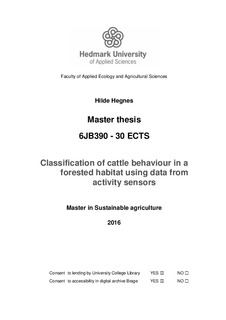Classification of cattle behaviour in a forested habitat using data from activity sensors
Abstract
GPS collars with activity sensors can be used to record movement and activity of free-ranging cattle. In forests grazed by cattle, resources are utilized where they exist, an important consideration for sustainable land use. Since animal behaviour can indicate state of health and nutrient uptake, monitoring grazing activity and classifying cattle behaviour based on collar recordings might contribute to provide sufficient welfare management. Several statistical methods have previously been trialled to classify behaviours using data from activity sensors, however, no method is standardised. This study mainly aims to use classification tree models to classify binary activity and grazing behaviour.
17 cattle on pasture in the forest of Stange and Romedal common land were equipped with dual-axis activity sensor collars and behaviour was observed during summer months of 2015, resulting in 1105 sequences of observed behaviour. Data from observations were used for testing accuracy of activity sensors to classify behaviour. Classification of binary activity (low vs. high) was 89.3%. When adding grazing as a category, classification was 80.8%. This suggests classification to be more difficult when adding more behaviour categories to the model and some behaviours are correlated to the same activity level. In addition to activity data from the collars, distance of movement between sequences was chosen by the model as an important variable to classify behaviour.
